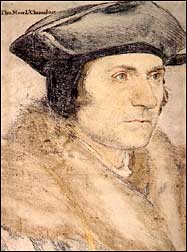|
|
|
|

Holbein's sketch of Thomas More
A Godly Instruction
[on How to Treat Those Who Wrong Us]
c.1534
Reflections written in the Tower.
Bear no malice nor ill-will to any man living; for, either the man is good, or naught: if he be good, and I hate him, then am I naught; if he be naught, either he shall amend, and die good, and go to God; or abide naught, and die naught, and so be lost. If he be saved, he shall not fail, if I be saved too, as I trust to be, to love me very heartily, and I shall then love him likewise. And why, then, should I now hate one, who shall hereafter love me for evermore?
and why should I now be an enemy to him, with whom I shall, in time coming, be coupled in eternal frendship?—On the other side, if he shall continue naught and be lost, that is so terrible and eternal a sorrow to him, that I should think myself a cruel wretch, if I did not now rather pity his pain, than malign his person. Should any one say, that we may, with a good conscience, wish an evil man harm, lest he should do harm to such as are innocent and good, I will not now dispute upon that point, for the matter requires to be more considered than I can now conveniently write, having no other pen than a coal. But, verily, thus will I say—that I will give counsel to every good friend of mine, if he be put in such a room as to punish an evil man, who lieth in his charge by reason of his office, at all events, to leave the desire of punishing unto God, and unto such folk as are so grounded in charity and cleave so fast to God, that no secret shrewd cruel affection, under the cloak of just and virtuous zeal, can creep in, and undermine them. But let us that are no better than men of a mean sort ever pray for such merciful amendment in others, as our conscience sheweth us we have need of in ourselves.
Source:
Walter, W. Joseph. Sir Thomas More: His Life and Times. 2nd Ed.
London: Charles Dolman, 1840. 314-5.
 |
to the Works of Sir Thomas More |
Site copyright ©1996-2018 Anniina Jokinen. All
Rights Reserved.
Created by Anniina Jokinen
on January 9, 2007. Last updated on December 11, 2018.
|
|
The Tudors
King Henry VII
Elizabeth of York
King Henry VIII
Queen Catherine of Aragon
Queen Anne Boleyn
Queen Jane Seymour
Queen Anne of Cleves
Queen Catherine Howard
Queen Katherine Parr
King Edward VI
Queen Mary I
Queen Elizabeth I
Henry Fitzroy, Duke of Richmond
Renaissance English Writers
Bishop John Fisher
William Tyndale
Sir Thomas More
John Heywood
Thomas Sackville
Nicholas Udall
John Skelton
Sir Thomas Wyatt
Henry Howard
Hugh Latimer
Thomas Cranmer
Roger Ascham
Sir Thomas Hoby
John Foxe
George Gascoigne
John Lyly
Thomas Nashe
Sir Philip Sidney
Edmund Spenser
Richard Hooker
Robert Southwell
Robert Greene
George Peele
Thomas Kyd
Edward de Vere
Christopher Marlowe
Anthony Munday
Sir Walter Ralegh
Thomas Hariot
Thomas Campion
Mary Sidney Herbert
Sir John Davies
Samuel Daniel
Michael Drayton
Fulke Greville
Emilia Lanyer
William Shakespeare
Persons of Interest
Cardinal Thomas Wolsey
Archbishop Thomas Cranmer
Thomas Cromwell
John Fisher, Bishop of Rochester
Cardinal Lorenzo Campeggio
Cardinal Reginald Pole
Stephen Gardiner, Bishop of Winchester
William Tyndale
Pico della Mirandola
Desiderius Erasmus
Christopher Saint-German
Thomas Linacre
William Grocyn
Hugh Latimer
Elizabeth Barton, the Nun of Kent
For more, visit Encyclopedia
Historical Events
Field of the Cloth of Gold, 1520
Pilgrimage of Grace, 1536
The Babington Plot, 1586
The Spanish Armada, 1588
Government
Oath of Supremacy
The Act of Supremacy, 1534
The First Act of Succession, 1534
The Third Act of Succession, 1544
The Ten Articles, 1536
The Six Articles, 1539
The Second Statute of Repeal, 1555
Images of London:
London in the time of Henry VII. MS. Roy. 16 F. ii.
London, 1510, earliest view in print
Map of England from Saxton's Descriptio Angliae, 1579
Location Map of Elizabethan London
Plan of the Bankside, Southwark, in Shakespeare's time
Detail of Norden's Map of the Bankside, 1593
Bull and Bear Baiting Rings from the Agas Map (1569-1590, pub. 1631)
Sketch of the Swan Theatre, c. 1596
Westminster in the Seventeenth Century, by Hollar
Visscher's Panoramic View of London, 1616. COLOR
For more, visit Encyclopedia
|
|